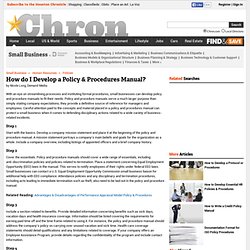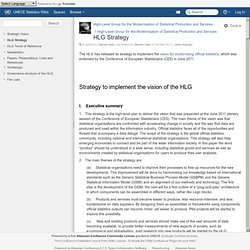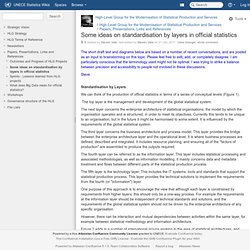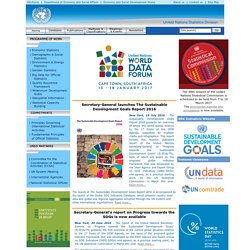

Spurious Correlations. How Do I Write a Standard Operations Procedures Manual? How to Start Writing Policies and Procedures - Bizmanualz. View Free Sample Policies & Procedures View free policies procedures examples from all manuals.

No obligation, no credit card! Any old policy and procedure format saves time by not having to start from scratch, right? Well, not necessarily. Using a weak starting point can hurt employee usability, introduce confusion and user-error, and may not assist in your compliance and control objectives. Drive Performance Improvement If your policies and procedures are incomplete, outdated or inconsistent, then you are probably not driving the performance improvement you intended.
Improve Your Results To be confident you’re buying a procedure template that gets the job done quickly and correctly, it’s important to examine its basic elements. Writing Policies and Procedures Procedures should be action oriented, grammatically correct, and written in a consistent style and format to encourage maximum usability. Improve Performance in All Departments Best Practices Saves Time.
How do I Develop a Policy & Procedures Manual? With an eye on streamlining processes and instituting formal procedures, small businesses can develop policy and procedure manuals to fit their needs.

Policy and procedure manuals serve a much larger purpose than simply stating company expectations; they provide a definitive source of reference for managers and employees. Careful attention paid to the concepts and material placed in a policy and procedures manual can protect a small business when it comes to defending disciplinary actions related to a wide variety of business-related incidents. Step 1 Start with the basics. High-Level Group for the Modernisation of Statistical Production and Services - High-Level Group for the Modernisation of Statistical Production and Services - Confluence. HLG Strategy - High-Level Group for the Modernisation of Statistical Production and Services - Confluence. The HLG has released its strategy to implement the vision for modernising official statistics, which was endorsed by the Conference of European Statisticians (CES) in June 2011.

I. Executive summary 1. This strategy is the high-level plan to deliver the vision that was presented at the June 2011 plenary session of the Conference of European Statisticians (CES). The main theme of the vision was that statistical organisations are confronted with accelerating change in society and the way that data are produced and used within the information industry. 2. (a) Statistical organisations need to improve their processes to free up resources for the new developments. (b) Products and services must become easier to produce, less resource-intensive, and less burdensome on data suppliers. Sharing Resources and Experiences in Statistical Data Collection - Data Collection - Confluence. METIS-wiki - Statistical Metadata (METIS) - Confluence.
Some ideas on standardisation by layers in official statistics - High-Level Group for the Modernisation of Statistical Production and Services - Confluence. The short draft text and diagrams below are based on a number of recent conversations, and are posted as an input to brainstorming on this topic.

Please feel free to edit, add, or completely disagree. I am particularly conscious that the terminology used might not be optimal. I was trying to strike a balance between precision and accessibility to people not involved in these discussions. Steve Standardisation by Layers. Ited Nations Statistics Division. New York, 1 June 2016 - The chair of the Statistical Commission, Ms.

Wasmalia Bivar of Brazil, addressed the Economic and Social Council (ECOSOC) on 1 June during its Coordination and Management Meeting. Ms. Bivar, who provided her briefing by videolink, informed the Council that the Statistical Commission at its last session in March had agreed “as a practical starting point” on a global indicator framework, which had been developed by the Inter-agency and Expert Group on Sustainable Development Goal Indicators (IAEG-SDGs). RAMON - Classification Detail List. About the Thesaurus. The Statistics Canada Thesaurus was developed to provide subject access to Statistics Canada's information resources. The Thesaurus is a bilingual, fully structured, indexing and information retrieval tool which conforms to internationally accepted standards and conventions for thesaurus construction.
It consists of descriptors and non-descriptors, accompanied by their hierarchical, associative and prescriptive relationships. Scope and exclusions The scope of the Thesaurus is dynamic and reflects subjects that have been addresssed at one time or another in Statistics Canada sources. Terms were selected from various Statistics Canada products, including publications, databases and related sources. The following types of concepts have been excluded from the Thesaurus: geographical names, titles (e.g., of surveys), proper names (e.g., of companies) and acronyms, except where they are in common usage. Language Term format and notes In general, terms are in the form of nouns or noun phrases. Yarn. Explanatory Notes. A. Introduction The OECD Glossary of Statistical Terms contains a comprehensive set of definitions of the main data items collected by the Organisation. The Glossary also contains definitions of key terminology and concepts and commonly used acronyms.
The definitions in the OECD Glossary are primarily drawn from existing international statistical guidelines and recommendations that have been prepared over the last two or three decades by international organisations (such as the United Nations, ILO, OECD, Eurostat, IMF) working with national statistical institutes and other agencies responsible for the initial compilation and dissemination of statistical data. A comprehensive list of these guidelines is located on the United Nations Statistical Division (UNSD) website, Methodological Publications in Statistics ( Another site listing almost all of the current international statistical classifications is provided on a Eurostat site - b. C. D. E. F. G. H.